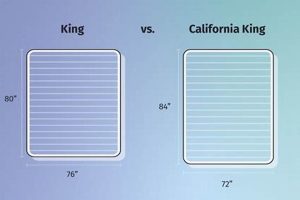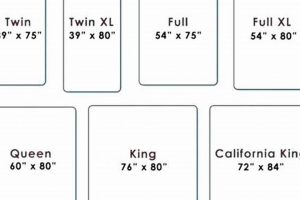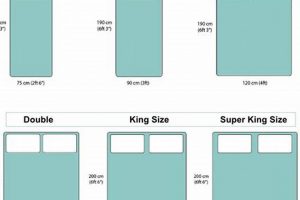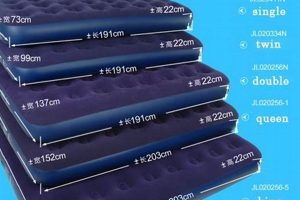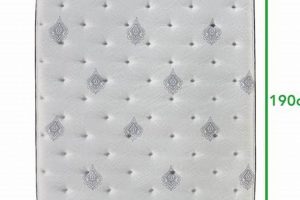The size specifications for sleeping platforms within recreational vehicles directly impact comfort and functionality. These measurements, typically expressed in length, width, and thickness, are crucial in selecting suitable bedding. For example, a compact travel trailer may accommodate a short queen, while a larger motorhome might feature a full-size or even a king-size sleeping area.
Accurate knowledge of these spatial requirements is essential for ensuring restful sleep and efficient use of limited interior space. Historically, standard residential bed sizes often proved impractical for mobile dwellings, leading to the development of specialized sizing. Benefits of optimized dimensions include improved sleep quality, enhanced cabin ergonomics, and reduced weight, contributing to better fuel efficiency and handling.
The following sections will address the common variations encountered, factors influencing selection, methods for accurate measurement, and alternative solutions for non-standard layouts. Detailed guides and recommendations are provided to assist in making informed decisions for enhanced travel experiences.
Optimizing Sleeping Arrangements in Recreational Vehicles
Selecting the appropriate size and type of bedding for a camper significantly impacts overall comfort and functionality. Consider these crucial points:
Tip 1: Prioritize Accuracy in Measurement: Measure the available space within the sleeping area of the recreational vehicle meticulously. Account for any obstructions or irregularities in the platform to ensure the chosen bedding fits precisely.
Tip 2: Understand Standard RV Sizes: Familiarize yourself with the common size designations used in the RV industry, such as short queen, RV king, and bunk sizes. These often differ from standard residential dimensions.
Tip 3: Account for Mattress Thickness: Consider the desired thickness. Thicker options may offer enhanced comfort but can also reduce headroom, particularly in overhead bunks or compact spaces.
Tip 4: Evaluate Weight Considerations: Lighter materials, such as memory foam or latex, can reduce the overall weight of the RV, potentially improving fuel efficiency and handling. Balance comfort with weight constraints.
Tip 5: Research Custom Options: For non-standard sleeping areas, explore custom-made options. These provide a tailored fit and maximize the use of available space.
Tip 6: Factor in Storage Requirements: Assess storage needs when selecting bedding. Folding or roll-up styles can be more easily stowed when not in use, freeing up valuable space.
Tip 7: Consider Partner Preferences: If sharing the sleeping area, discuss preferences regarding firmness, material, and support to ensure both individuals achieve adequate rest.
Careful consideration of these factors enables a well-informed decision, resulting in improved sleep quality and enhanced enjoyment of recreational vehicle travel.
The subsequent sections of this article will delve into specific sizing charts, material properties, and maintenance recommendations to further assist in optimizing the sleeping environment within a camper.
1. Length
The dimension of length represents a fundamental aspect of camper mattress specifications, dictating the compatibility of the bedding with the available sleeping platform. Insufficient length can result in discomfort due to inadequate support for the lower extremities, potentially leading to disrupted sleep patterns. Conversely, excessive length may impede movement within the camper or obstruct access to storage compartments. A standard queen mattress, commonly 80 inches in length, might be unsuitable for a smaller travel trailer designed for a short queen, typically 75 inches. The discrepancy necessitates careful measurement and consideration of available space.
The selection of appropriate length has a direct impact on the overall ergonomics of the sleeping area. For example, individuals over six feet in height require a length of at least 76 inches to avoid having their feet extend beyond the mattress edge. Failing to account for individual height can lead to postural issues and chronic back pain during extended travel. Moreover, considerations extend beyond mere comfort. The length can influence safety, preventing obstruction of emergency exits or access to essential equipment within the camper. Accurate determination of length is therefore paramount in ensuring both comfort and safety.
In summary, length is a critical variable in the selection process. A mismatch between the mattress and the available platform has direct, measurable consequences on sleep quality, ergonomics, and safety. While other dimensions warrant consideration, length serves as a primary constraint in determining compatibility and suitability. Understanding and accounting for this dimension is essential for optimizing the recreational vehicle sleeping environment.
2. Width
Within the realm of camper bedding, the measurement of width directly dictates the sleeping surface available per individual and the ease of movement within the confined space. Inadequate width can lead to compromised sleep quality and discomfort, particularly when shared with a partner. Conversely, excessive width may impede access to other areas within the camper or necessitate modifications to existing structures.
- Individual Occupancy Comfort
The width determines the available lateral space for an occupant. A narrow width, typically found in twin-size configurations, restricts movement and can lead to feelings of confinement. Adequate width, such as that found in a full or queen-size mattress, provides more personal space and facilitates greater freedom of movement during sleep, contributing to a more restful experience. Inadequate width forces occupants to remain in a fixed position, increasing the likelihood of discomfort and muscle stiffness.
- Two-Person Accommodation
When the sleeping area is shared, width assumes paramount importance. Insufficient width necessitates close proximity, potentially disrupting sleep due to partner movements or temperature regulation differences. A wider sleeping surface, such as a queen or king-size, provides greater separation, mitigating these disturbances. The distribution of weight across the sleeping surface is also affected by the width, potentially impacting the lifespan and structural integrity of the bedding.
- Passageway Constraints
The chosen width affects available space for passage within the camper. A wider mattress can restrict access to storage areas, bathroom facilities, or other essential zones. In smaller recreational vehicles, even a few inches of extra width can significantly impact maneuverability. Careful consideration of this trade-off between sleeping comfort and ease of movement is essential for optimizing the camper’s layout.
- Compatibility with Camper Structure
The existing dimensions of the campers sleeping platform constrain width options. Standard residential sizes often do not align with recreational vehicle configurations, necessitating the use of specialized or custom-made bedding. Alterations to the camper’s structure to accommodate a wider mattress may be possible, but such modifications require professional expertise and can incur significant expense. Furthermore, such modifications may affect the structural integrity or resale value of the vehicle.
In summary, the dimension of width represents a critical factor in determining the suitability of bedding for recreational vehicles. The selection of an appropriate width requires careful consideration of individual occupancy needs, the potential for shared occupancy, passageway constraints within the camper, and compatibility with the existing structural framework. An optimal width balances comfort, functionality, and spatial efficiency, contributing to an enhanced travel experience. Choosing a width that is too great can cause restrictions. Choosing a width that is too small can diminish comfort.
3. Thickness
Thickness, a key component of camper mattress dimensions, directly influences comfort, support, and spatial efficiency within the confined environment of a recreational vehicle. This dimension not only determines the level of cushioning but also affects headroom and storage capacity, necessitating a careful balance between comfort and practicality.
- Support and Pressure Relief
Greater thickness generally corresponds to increased support and pressure relief. Thicker options often incorporate multiple layers of foam or innerspring systems, distributing weight more effectively and reducing pressure points. This is particularly crucial for individuals with back pain or joint issues. However, excessive thickness may compromise stability, especially on uneven surfaces or in vehicles with limited headroom. For example, a 12-inch memory foam mattress may provide superior comfort compared to a 6-inch alternative but could make sitting upright in a low-profile camper bunk difficult.
- Headroom Constraints
The available headroom within a camper is a critical factor when determining acceptable thickness. Bunks, overhead compartments, and other confined sleeping areas often have limited vertical space. Selecting a mattress that is too thick can restrict movement, create a claustrophobic environment, and impede ventilation. Conversely, a mattress that is too thin may provide insufficient cushioning and support, leading to discomfort and disrupted sleep. A balance must be struck to maximize comfort without sacrificing headroom. Consider pop-up campers where the roof lowers and headroom is crucial.
- Weight Considerations
Thickness directly correlates with weight. A thicker mattress typically contains more material, increasing the overall load on the recreational vehicle. Excessive weight can negatively impact fuel efficiency, handling, and the vehicle’s load capacity. Lightweight materials, such as high-density foam or specialized air chambers, can mitigate this issue, but may come at a higher cost. In smaller trailers, every pound counts and the decision on thickness becomes very important for the owner. Weight is an overlooked component, which may cause serious problems.
- Storage and Transport
The thickness of the bedding also affects storage and transport considerations. Thicker options may be more difficult to compress or fold, requiring larger storage compartments. In recreational vehicles where space is at a premium, this can be a significant drawback. Roll-up or folding styles offer a practical alternative, but may compromise comfort compared to traditional mattresses. For seasonal storage, the mattress may need to be kept in the house or garage where its thickness may present challenges.
In conclusion, thickness is an inseparable aspect of camper mattress dimensions, exerting influence on comfort, headroom, weight, and storage. The optimal choice necessitates a comprehensive evaluation of individual needs, spatial constraints, and the overall design of the recreational vehicle. The wrong thickness can result in poor sleep, handling problems, and storage issues. The correct choice ensures that every inch is maximized for enjoyment.
4. Shape
The shape of a camper mattress constitutes a critical factor within the broader context of camper mattress dimensions, directly influencing spatial utilization and sleeping comfort within the often-constrained confines of a recreational vehicle. Deviations from standard rectangular forms necessitate careful consideration to optimize the available sleeping area.
- Corner Configurations
Many campers incorporate curved or angled corners within their sleeping platforms to maximize floor space or accommodate structural elements. Standard rectangular mattresses cannot conform to these irregularities, resulting in wasted space or an incomplete sleeping surface. Mattresses with custom-cut corners or rounded edges address this issue, ensuring a snug fit and preventing gaps that could compromise comfort or safety. The presence of wheel wells is a primary driver of shape changes.
- Tapered Designs
In certain camper layouts, particularly those featuring bunk beds or convertible seating, the sleeping area may taper towards one end. This design necessitates a mattress with a corresponding taper to provide consistent support and prevent sleepers from sliding off the edge. Such tapered designs are common in teardrop trailers and pop-up campers, where efficient use of space is paramount.
- Folding and Hinged Sections
Convertible furniture within campers often incorporates folding or hinged sections to transform seating areas into sleeping surfaces. Mattresses designed for these configurations must possess corresponding hinges or folds to allow for seamless transitions between modes. These folding mattresses typically consist of multiple interconnected sections that can be arranged in various configurations to accommodate different furniture arrangements. The main advantage is multi-use purposes of the furniture.
- Specialized Cutouts
Certain campers feature built-in fixtures or appliances that intrude into the sleeping area, requiring specialized cutouts in the mattress to accommodate these obstructions. Examples include wheel wells, plumbing fixtures, or electrical panels. These cutouts must be precisely dimensioned to ensure a secure fit and prevent damage to the mattress or the underlying fixtures. In some designs, an alternative solution to a cutout is to build an elevated sleeping platform over these fixtures. This maximizes flat surface at the expense of total available volume in the camper.
These shape considerations highlight the importance of tailoring bedding to the specific spatial constraints of each camper. Standard mattresses often prove unsuitable, necessitating custom solutions to optimize comfort and functionality. The careful selection and configuration of the mattress shape are essential to achieving a restful and enjoyable sleeping experience within a recreational vehicle. Ignoring the contours within the camper can lead to a variety of different complications, so measurement and planning are key.
5. Weight
The weight of a camper mattress is a critical consideration intertwined with its dimensions, directly influencing the overall performance and safety of the recreational vehicle. Its relevance extends beyond mere portability, affecting fuel efficiency, handling characteristics, and structural integrity.
- Impact on Fuel Efficiency
Increased weight directly correlates with reduced fuel economy. A heavier mattress adds to the overall load of the camper, requiring more energy to propel the vehicle. This effect is particularly pronounced on inclines or during extended travel. Choosing lighter materials, such as memory foam or latex, can mitigate this effect. A significant difference in mattress weight will translate to a discernible impact on the miles per gallon achieved during travel. A heavier load places a large load on the engine to complete the journey.
- Influence on Handling and Stability
Excessive weight, especially when concentrated in the upper portions of the camper, can compromise stability and handling. A heavy mattress positioned in an overhead bunk can raise the center of gravity, making the vehicle more susceptible to swaying or tipping, particularly during cornering or in windy conditions. Distributing weight evenly, with lighter materials in elevated areas, improves overall vehicle dynamics and driver control. Vehicle dynamics are also important for passengers.
- Effects on Load Capacity and Tire Wear
Every recreational vehicle has a maximum load capacity, and exceeding this limit can damage the vehicle’s suspension, tires, and frame. A heavy mattress contributes to the overall load and reduces the available capacity for other essentials. Overloading the vehicle also increases tire wear, reducing tire lifespan and potentially leading to blowouts. Careful calculation of all cargo weights, including the bedding, is essential to ensure safe operation. Safe operation is of the utmost importance when traveling.
- Considerations for Lifting and Maneuvering
The weight of the mattress also affects its ease of handling during setup and takedown of the camper. A heavier mattress can be difficult to lift, maneuver, or store, particularly for individuals with limited strength or mobility. Folding or roll-up mattresses offer a more manageable alternative, reducing both weight and storage space requirements. This is especially important if the mattress needs to be removed for cleaning or airing out. Furthermore, if the mattress needs to be replaced, lifting and maneuvering is essential to the replacement process. If the mattress is too heavy to lift, the replacement process may need to be completed by two individuals.
These facets underscore the significant interplay between weight and the dimensional attributes of camper mattresses. The choice of materials, size, and construction should reflect a comprehensive understanding of their combined impact on fuel consumption, vehicle stability, load capacity, and ease of handling. Optimizing these factors ensures a safer, more comfortable, and more efficient travel experience. The wrong decision can impact the enjoyment of travel.
6. Density
Density, a fundamental property of camper mattress materials, significantly influences the relationship between the overall size specifications and the functional characteristics. It is defined as the mass per unit volume, typically expressed in pounds per cubic foot (lb/ft). Higher density generally equates to increased durability, enhanced support, and reduced long-term compression, impacting the longevity and comfort. Lower density results in cost savings.
- Support and Conformity
Density dictates the degree of support offered by the mattress. High-density foams, for instance, provide firm support, distributing weight evenly and minimizing pressure points. Lower density options may conform more readily to body contours but can lack adequate support for heavier individuals, potentially leading to discomfort or spinal misalignment. A high-density memory foam mattress maintains its shape and resists sagging over time. This is important for those sleeping on the mattress night after night.
- Durability and Longevity
Density directly affects the lifespan. Higher density materials are more resistant to wear and tear, compression, and deformation, resulting in a more durable and long-lasting mattress. Lower density foams are more prone to breakdown and sagging over time, requiring more frequent replacement. A high-density latex mattress may retain its original form and support characteristics for a decade or more, whereas a low-density foam option may degrade within a few years.
- Weight Considerations
Density is intrinsically linked to weight. While a higher density mattress offers superior support and durability, it also adds to the overall weight of the camper. This can impact fuel efficiency and handling, as previously discussed. Balancing the need for support and longevity with weight constraints is essential. High-density foam, while durable, contributes more to the vehicle’s load than a less dense alternative.
- Thermal Properties and Ventilation
Density affects airflow and heat retention within the mattress. Denser materials tend to trap more heat, potentially leading to discomfort for sleepers who are prone to overheating. Lower density foams often exhibit better ventilation, promoting airflow and reducing heat buildup. Open-cell foam structures, regardless of density, enhance breathability compared to closed-cell alternatives. Open cell structures allow breathability and air to circulate within the mattress.
These interconnected facets reveal that density serves as a pivotal attribute governing the relationship between camper mattress dimensions and performance characteristics. Optimizing density involves a nuanced understanding of its influence on support, durability, weight, and thermal properties, ensuring a judicious balance that aligns with individual needs and the specific requirements of recreational vehicle travel. Choosing the wrong density can lead to a mattress which either breaks down quickly or adds to the weight to the vehicle.
7. Material
The composition of a camper mattress, defined by its constituent materials, critically influences several dimensional attributes and associated performance characteristics. Material selection impacts weight, thickness, and overall durability, which are directly relevant to optimizing the sleeping environment within a recreational vehicle. For instance, a high-density memory foam mattress offers superior conforming support, often requiring a greater thickness to achieve optimal pressure relief, thereby adding to the overall weight. Conversely, an innerspring mattress, utilizing a coil system, may achieve similar support at a lower overall thickness, but potentially at the cost of increased weight due to the metal components. The choice between these materials represents a direct trade-off affecting both the dimensions and the functional properties.
Furthermore, material properties influence compressibility and conformability within constrained spaces. Latex, known for its elasticity, can be compressed and manipulated more readily than a traditional innerspring mattress, allowing it to fit into irregularly shaped sleeping areas or storage compartments. This is of particular relevance when dealing with the non-standard dimensions often encountered in campers. The material’s ability to resist degradation from moisture and temperature fluctuations also impacts its long-term dimensional stability. Closed-cell foams, for example, resist water absorption better than open-cell alternatives, maintaining their structural integrity and preventing dimensional changes that could compromise comfort or fit.
In summation, material selection is inextricably linked to the dimensional profile of a camper mattress. Material-driven considerations affect weight, thickness, compressibility, and long-term durability, each of which has practical consequences for comfort, spatial efficiency, and vehicle performance. The selection of materials must reflect a comprehensive understanding of these interdependencies to achieve an optimal balance between performance and practical constraints in the context of recreational vehicle travel. Careful consideration will prevent issues in the near future.
Frequently Asked Questions
This section addresses common inquiries and misconceptions regarding the size specifications of sleeping platforms within recreational vehicles.
Question 1: What is the standard size of a “short queen” mattress commonly found in campers?
A “short queen” typically measures 60 inches in width and 75 inches in length, differing from a standard residential queen’s 80-inch length.
Question 2: How does mattress thickness affect headroom in a camper bunk?
Increased thickness reduces available headroom, potentially creating discomfort or limiting movement within the bunk. Measure available vertical space carefully.
Question 3: Can a standard residential mattress be used in a camper?
Standard residential mattresses are often unsuitable due to dimensional differences and may not fit properly within the confines of a recreational vehicle.
Question 4: What factors should be considered when choosing a mattress for a camper with limited storage?
Folding or roll-up mattresses offer compact storage solutions, sacrificing some comfort compared to traditional mattresses. Assess available storage space accurately.
Question 5: How does mattress weight impact fuel efficiency in a recreational vehicle?
Excessive mattress weight increases the overall load of the vehicle, reducing fuel efficiency. Lighter materials mitigate this effect.
Question 6: Are custom-sized mattresses a viable option for non-standard camper sleeping areas?
Custom-sized mattresses provide a tailored fit, maximizing comfort and space utilization in uniquely shaped or dimensioned sleeping areas.
The information presented emphasizes the importance of precise measurement and understanding specialized sizing considerations when selecting bedding for campers.
The subsequent segments of this discussion will explore material options and maintenance protocols in greater detail.
Camper Mattress Dimensions
This exploration has underscored the critical importance of understanding and precisely addressing spatial considerations within recreational vehicles. The specifications of sleeping surfaces directly affect comfort, safety, and overall functionality. Detailed attention to length, width, thickness, shape, density, weight, and material is essential to optimize the limited space in a mobile living environment.
Ignoring these aspects can lead to compromised sleep, reduced fuel efficiency, and potential safety hazards. Diligence in measurement, material selection, and consideration of vehicle-specific constraints will ensure a safer and more enjoyable travel experience. Thoughtful decision-making yields dividends in comfort, practicality, and long-term durability, solidifying the significance of camper mattress dimensions.


